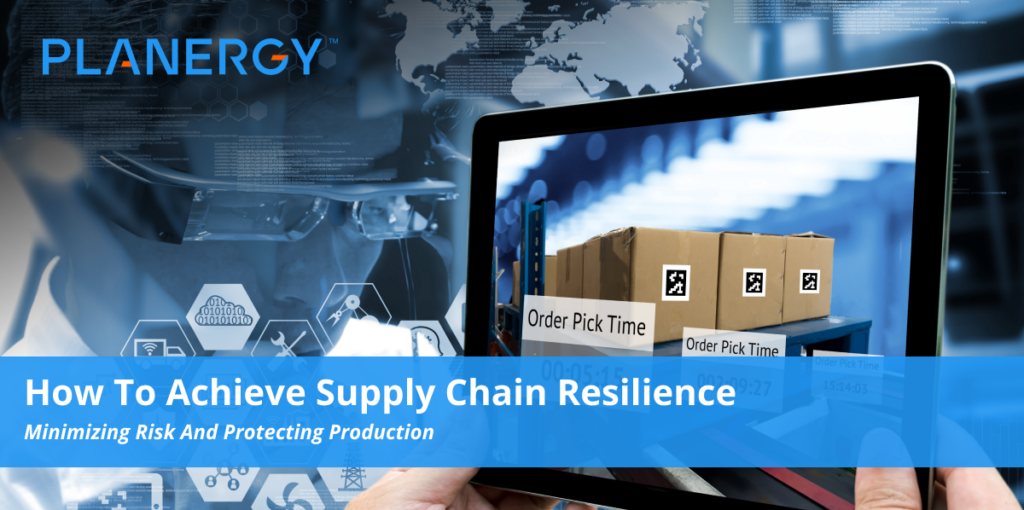Supply chain managers looking to build optimal profitability and minimal supplier risk into their supply chain strategy face special challenges in the modern marketplace.
As global supply chains grow larger, longer, and more complex, supply chain disruptions become an increasingly potent source of potential disaster.
Accordingly, it’s supply chain resilience—the ability of an organization’s supply chain to “roll with the punches” and execute contingencies to protect production and profits when the unexpected occurs—that’s job one for many supply chain management specialists.
Understanding the importance of supply chain resilience is simple enough, but what about actually achieving it? It’s not as difficult as you might think; with the right resilience strategies and technology, you can ensure your supply is flexible and strategically strong enough to weather the unexpected with aplomb.
What is Supply Chain Resilience?
While the importance of developing at least some form of plan to combat the dangers of the unknown is as old as enterprise itself—as a familiar adage says, “Hope for the best, but plan for the worst.”
And yet, for those doing business in today’s world, finding ways to understand what constitutes supply chain resilience, and then implement it as part of their larger business process management systems, is critical to maintaining competitive advantage and business continuity.
Contemporary supply chains can span the entire globe, and are often rife for potential disaster in numerous forms, including but not limited to:
- Natural disasters
- Political conflict
- Economic downturns
- War
- Terrorist attacks
- Epidemics
One way data scientists divide risks inherent to a global supply chain is with a bifurcated model that splits resilient sourcing based on the type of potential risk, the approach to risk management, and the type of sourcing used.
Under such a model—referred to as a two-stage stochastic model—risk is acknowledged as inherently random factor that can nevertheless be mitigated through data analysis and strategic decision-making, whether a business relies on single sourcing or multiple sourcing.
A 2017 study published in the International Journal of Production Research found that well-informed businesses that took a collaborative approach to supply chain management (i.e., collaborative both internally and in working with supply chain partners) were much more successful in achieving supply chain resiliency, due in large part to greater transparency into vendor performance, compliance, and other data.
When it comes to supply chain management, forewarned is indeed forearmed, it seems.
Developing the kind of supplier relationships that make flexibility and foreknowledge possible takes work, however.
There’s no single magic formula for anticipating and negating all risk, but actively pursuing resilience can provide the cushion an organization’s supply network needs to overcome disruptions.
Businesses, like individuals, demonstrate resilience through their ability to persevere and “bounce back” from the unexpected. In a person, such resilience might be demonstrated by an athlete recovering from a serious injury and demonstrating the same, or even improved, levels of skill.
For organizations, resilience can be demonstrated by how quickly it bounces back from disruption and returns to (or exceeds) expected performance levels for service, production, order fulfillment, etc.
Traditionally, the defining trait of a resilient supply chain was reduced risk by avoiding disruption (particularly supplier risk, although in time risk associated with process inefficiencies, accounting methodologies, etc. became important as well).
Today, however, supply chain resilience is more proactive; rather than simply reducing risk by seeking to avoid disruption altogether, a resilient supply chain management strategy views disruptive events as opportunities for process improvement and stronger competitive advantage.
Transforming disruptions that would’ve once been viewed purely as disastrous into opportunities for improvement requires a significant investment of time and talent.
Ensuring the organization’s supply chain network possesses the redundancy and flexibility required to ensure risk mitigation without delaying production, halting essential internal processes, or damaging supplier relationships can seem quite tricky to the uninitiated.
In addition, organizations developing a resilient supply chain strategy should be prepared to invest in cultural transformation, as resilience requires proactivity, significant process improvement, and effective communication and collaboration to succeed.
This may prove especially challenging for “old school” firms still relying on traditional supply chain models, conservative cost/risk reduction paradigms, and manual processes.
In focusing on these three traits—redundancy, flexibility, and cultural transformation—you can build the framework necessary to forge the complex and versatile supply chain environment necessary to integrate digital transformation, shift focus from savings and risk aversion to value creation, and actively transform disruptions into opportunities for greater success.
Should a key supplier of raw materials, components, or finished goods experience significant disruption, your business could be facing not just disaster, but destruction.
Building a Truly Resilient Supply Chain
Taking a closer look at the three-prong approach to building supply chain resilience, we see that industry-leaders address each aspect in key ways.
Increased Redundancy
At first blush, redundancy may seem like the most powerful tool available when seeking to build resilience into your supply chain risk management model.
After all, the more suppliers you have, the more options you have for contingency plans that preserve your own production and sales when the shipping of essential raw materials is shut down by ecological disaster, or borders close in the wake of political unrest or canceled trade agreements.
Redundancy also enables you to hold additional inventory to cover protracted delays or outages.
However, it must be said that of the three aspects necessary to build resilience, redundancy is of the briefest utility, and generates significant expense.
Much of this expense comes from simply having to manage excess inventory as safety stock.
Time, space, and effort devoted to tracking and maintaining this inventory, as well as the contingency plans utilizing it, can quickly generate costs that might be something of a disaster in themselves.
And consider this: not only does your company have to pay for the safety stock purchased, but you must direct resources such as time, staff, and expense to developing and maintaining relationships with vendors in your supply base whose utility and value are quite limited compared to that of key suppliers.
Ultimately, redundancy is of maximum utility for your business when used sparingly and within a larger inventory management framework such as Six Sigma, where the focus on efficiency, just-in-time inventory management, and the like will allow you to take advantage of redundancy’s merits while minimizing its potential pains.
Enhanced Flexibility
Like a well-trained acrobat or gymnast, a flexible procurement organization can overcome the negative impact of disruptive events by nimbly executing the appropriate contextual response.
To ensure such flexibility is “baked into” their supply chain management processes, businesses should:
- Standardize and automate workflows and processes.
In addition to standardizing as many components and parts as possible, standardizing plant and warehouse designs, and documenting formalized processes, you can make it easier to adopt a flexible “plug & play” approach. Such a system makes it easy to move parts and components internally, bring staff up to speed on critical processes as needed, and direct resources where they’re needed most with the greatest speed and efficiency.
Standardization is of crucial importance to supply chain flexibility. But implementing process automation—particularly as supported by advanced technological tools such as artificial intelligence (AI), deep data analytics, and software robots—can be an even greater source of created value and recaptured expenses. Using a procurement software solution with a supplier management module can make all the difference.
Process automation improves flexibility by standardizing time-consuming, high-volume processes with computer-controlled speed, accuracy, and efficiency. They also allow for more effective use of concurrent, rather than sequential, processes. Centralized, cloud-based data management lets you develop and manage complex processes with shared dependencies that run together, rather than forming a queue. For example, connecting your supply chain management to your sales, design, and marketing departments, you can quickly develop and execute product changes based on limited or changing material availability, update your customers, and still meet demand.
Data analytics can help your supplier management team develop contingencies for a wide array of disruptions, and optimize your supply chain to ensure maximum coverage and minimal supplier bloat.
Those same analytics also provide real-time monitoring of all the processes in your supply chain, enabling smarter strategic sourcing in general, as well as more proactive buying and stronger supplier relationship development through shared opportunities for innovation and growth.
Finally, automated processes introduce value from gains to efficiency and accuracy while still allowing your team to use tools such as spot purchasing—i.e., paying market price for commodities for same-day purchases. - Prioritize Supplier Relationship Management
Should a key supplier of raw materials, components, or finished goods experience significant disruption, your business could be facing not just disaster, but destruction. As an essential part of your company’s production, your key suppliers absolutely merit the time and energy devoted to their continued success and availability.
And while not every vendor can be a key supplier, your lower-tier and contingency suppliers still represent important opportunities for relationship building. The stronger and more intimate your knowledge of your supply chain, the better equipped your team will be to identify and address risk exposure before it can balloon into catastrophe.
As with process automation, ensuring your procurement and supply chain software solution has best-in-class supplier relationship management tools can prove immensely helpful. With all your vendor data available in real time, tools such as vendor dashboards and portals, and integration of your software environment with those of your most important suppliers, you’ll have the business intelligence necessary to spot not just potential problems, but opportunities for further growth or even competitive advantage against less well-prepared competitors.
Cultural Transformation
What do companies such as Nokia, Dell, UPS, and the United States Navy have in common? A shared dedication to supply chain resilience.
All of these organizations have integrated certain standards into their organizational culture that support strategic and resilient supply chains, including:
- Education, tools, and training to ensure complete buy-in for continuous improvement, flexibility, and innovative responses to unexpected challenges from all parties involved.
- Tactical and strategic responses developed through dealing with actual disruptions.
- Continuous, transparent, and collaborative communication between staff, management, and vendors.
- Empowerment of all stakeholders to act on information related to disruptions and begin contingency processes that protect business continuity and competitive performance.
How Resilient Is Your Supply Chain?
When disruption comes calling, will your business rise to meet the challenge, or find itself on the ropes? Achieving supply chain resilience is a complex and challenging process, but it’s absolutely possible for those companies willing to invest in the technology, techniques, and cultural changes that support it.
Prioritize resilience in your supply chain, and ensure your organization is ready to take a licking but keep on ticking.




